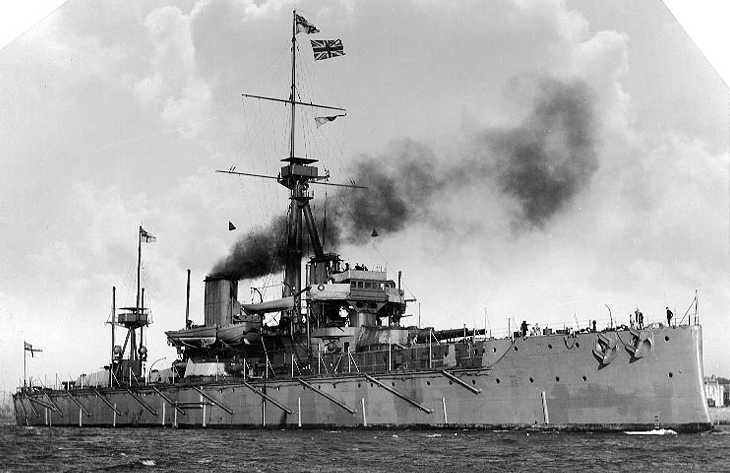
A Vickers design used on the famous British battleship HMS Dreadnought, which was the first battleship completed with an "all big gun" main armament.
These guns were originally developed for the two ships of the Lord Nelson class, the last of the British pre-dreadnoughts. The mountings and guns intended for those ships were instead used to speed the construction of HMS Dreadnought. As a result, construction on the Lord Nelson class was held up while new guns and mountings were built for them, delaying their completion until 1908. Thus, these last British "pre-dreadnoughts" were actually finished two years after their design had been obsoleted by HMS Dreadnought. Besides those ships actually completed with these guns, there were plans to replace the 12"/40 (30.5 cm) Mark IX guns used on the last three King Edward VII class (Africa, Britanica and Hibernia) but this conversion was abandoned.
In addition to their use on capital ships, a further three guns with four spares were mounted as coastal artillery in Belgium during World War I.
Constructed of nickel-steel inner A and A tubes, full length wire, B tube and overlapping jacket. The breech bush screwed into the A tube and then were both shrunk and screwed on to collars on the latter. These guns used a mechanically improved breech mechanism of "pure couple" design that could be either manually or hydraulically worked. This proved so successful that it was essentially copied in all later designs. 133 Mark X guns were manufactured plus two Mark X* guns, which was to an earlier design with a thinner chase and weighed 448 lbs. (203 kg) less. Mark X** and Mark X*** were alterations for railway guns but no guns were actually altered. Tapered inner A tubes to combat "steel choke" problems were approved during World War I but the three guns ordered were cancelled at the end of the war. In January 1920 eighty-five guns were offered to the Army and Empire forces for use in coastal batteries but none were transferred.
| Designation | 12"/45 (30.5 cm) Mark X |
|---|---|
| Ship Class Used On | Lord Nelson, Dreadnought, Bellerophon, Invincible and Indefatigable classes |
| Date Of Design | 1903 |
| Date In Service | 1908 |
| Gun Weight | Without Breech: 127,232 lbs. (57,711 kg)
With Breech: 129,348 lbs. (58,626 kg) |
| Gun Length oa | 556.5 in (14.135 m) |
| Bore Length | 540 in (13.716 m) |
| Rifling Length | 453.2 in (11.511 m) |
| Grooves | (60) 0.1 in deep x 0.467 in wide (2.5 mm D x 11.9 mm W) |
| Lands | 0.161 in (4.1 mm) |
| Twist | Uniform RH 1 in 30 |
| Chamber Volume | 18,000 in3 (295 dm3) |
| Rate Of Fire 1 | about 1.5 rounds per minute |
- ^The Rate of Fire figure given above is found in references for British guns of this caliber, but "Warrior to Dreadnought: Warship Development, 1860-1905" quotes Jellicoe's 1906 figures for rates of fire for these guns in gunlayers' tests and in battle practice and notes that the latter figures corresponded well to those actually attained by the Japanese at Tsushima:
Gunlayers Test: 2 rounds per minute
Battle Practice: 1 round per minute
| Type | Bag |
|---|---|
| Projectile Types and Weights 1a | APC Mark VI (2crh): 850 lbs. (386 kg) 2a APC Mark VIa (4crh) 2a 3a: 859.4 lbs. (389.8 kg) APC Mark VIIa (Greenboy - 4crh) 2a 4a: 854 lbs. (387.4 kg) CPC Mark VIIa (4crh): 850 lbs. (386 kg) HE Mark IIa (4crh): 850 lbs. (386 kg) Shrapnel: 850 lbs. (386 kg) |
| Bursting Charge | APC Mark VI: 26.3 lbs. (11.9 kg)
APC Mark VIa: 27.3 lbs. (12.4 kg) APC Mark VIIa: 20.3 lbs. (9.2 kg) CPC Mark VIIa: 80 lbs. (36.3 kg) HE Mark IIa: 106.5 lbs. (48.3 kg) |
| Projectile Length | APC Mark VI: 39.7 in (100.8 cm)
APC Mark VIa: N/A APC Mark VIIa: 38.0 in (96.5 cm) CPC Mark VIIa: 48.4 in (122.9 cm) HE Mark IIa: 48.3 in (122.7 cm) |
| Propellant Charge | 258 lbs. (117 kg) MD45 |
| Muzzle Velocity | 2,725 fps (831 mps) |
| Working Pressure | 18 tons/in2 (3,150 kg/cm2) |
| Approximate Barrel Life | 220 rounds 5a |
| Ammunition stowage per gun 6a | 80 rounds |
- ^Projectile weights from ADM 186/169. The sources below disagree as to muzzle velocity, propellant charge weights and maximum ranges. I have chosen to use those values given in "Jutland: An Analysis of the Fighting."
- ^The Royal Navy started experimenting with 4crh projectiles in 1908. These experiments were conducted by simply replacing the existing 2crh ballistic caps on 12-inch APC projectiles with 4crh caps. Later, the shell body and AP caps were also redesigned. Starting in 1909, these new 4crh projectiles were issued to the fleet but at first only to the Bellerophon and Indefatigable classes and then to the newer ships as they were commissioned. The older ships continued to use the 2crh projectiles, probably because of cost reasons. In 1915-16, 4crh projectiles were issued to HMS Dreadnought and to the Invincible class. Apparently, the Lord Nelson class used 2crh projectiles throughout their careers.
- ^"Greenboys" were issued starting in 1918.
- ^In 1908 estimated life with Cordite MD was 200 rounds. This was raised to 280 rounds in 1915.
- ^This is the peacetime outfit which consisted of 24 APC, 40 CP and 16 HE, all of which were 2crh. APC and CP were black powder filled while HE was lyddite filled. When the war started the outfit was increased to 110 rounds per gun in most ships. At the time when 4crh projectiles were issued to the Invincible class, the outfit was 33 APC, which were lyddite and black powder filled, 38 CPC and 39 HE. This outfit changed by mid-1916 to 44 APC, 33 CPC and 33 HE. A few shrapnel rounds were carried during the war at various times. The final outfit for the Invincible class after the war was 77 APC, which were shellite filled, and 33 CPC. The Indefatigable class carried a peacetime outfit of 24 APC, 28 CPC, 28 HE and 6 shrapnel. The initial war outfit was 33 APC, 38 CPC and 39 HE, later changed to be the same as the Invincible class. The Bellerophon class upon completion carried 24 APC, 40 CPC and 16 HE, which were lyddite filled, per gun.
| Elevation | Range |
|---|---|
| 13.5 degrees | 16,450 yards (15,040 m) |
| Elevation | Range |
|---|---|
| 13.5 degrees | 18,850 yards (17,236 m) |
| 16 degrees | 20,435 yards (18,690 m) |
| 45 degrees
Coastal artillery |
about 25,000 yards (22,860 m) |
| Elevation | Range | Striking Velocity | Angle of Fall |
|---|---|---|---|
| 0.54 degrees | 1,500 yards (1,370 m) | 2,483 fps (757 mps) | 0.7 |
| 3.0 degrees | 6,000 yards (5,480 m) | 1,884 fps (574 mps) | 3.8 |
| 6.1 degrees | 10,000 yards (9,140 m) | 1,497 fps (456 mps) | 8.9 |
| 11.8 degrees | 15,000 yards (13,720 m) | 1,179 fps (359 mps) | 20.0 |
| 20.7 degrees | 20,000 yards (18,290 m) | 1,103 fps (336 mps) | 37.3 |
| 40.1 degrees | 24,075 yards (22,010 m) | 1,093 fps (333 mps) | 66.9 |
The data in this last table is from the mathematical study "Unyielding Air: Aerodynamic Drag and Long Range Gunnery" by P.G. Pugh. As such, it may not accurately reflect the actual performance of these guns. It should also be noted that the performance given for elevations of 20.7 and 40.1 degrees would apply only to weapons used as coastal artillery.
| Range | KC Side Armor | Striking Velocity |
|---|---|---|
| 0 yards (0 m) | 16.0" (406 mm) | 2,850 fps (869 mps) |
| 10,000 yards (9,144 m) | 10.6" (269 mm) | 1,900 fps (579 mps) |
This data is from "British Battleships of World War Two" for an uncapped AP shell striking a plate at 90 degrees, i.e., with the axis of the shell perpendicular to the face of the plate. A capped shell would show about 10 to 20% improvement at low velocities and about 30 to 50% improvement at high velocities.
| Range | KC Side Armor |
|---|---|
| 7,600 yards (6,950 m) | 12" (305 mm) |
Data from "British Battleships: 1860 - 1950" and may reflect the performance of an APC projectile.
In 1912 DNO produced a table of penetration of KC armor by the Mark X guns. Penetration was in terms of calibers penetrated by 2crh and 4crh shells. Data from "Naval Weapons of World War I."
| Range | AP 2crh |
|---|---|
| Between 10,000 and 12,000 yards (9,140 and 10,970 m) | 5/12 |
| Between 8,000 and 10,000 yards (7,320 and 9,140 m) | 7/12 |
| 8,000 and 6,000 yards (7,320 and 5,490 m) | 3/4 |
| 6,000 and below yards (5,490 and below m) | 4/3 |
| Range | AP 4crh | CCP 4crh |
|---|---|---|
| Between 10,000 and 12,000 yards (9,140 and 10,970 m) | 2/3 | 1/3 |
| Between 8,000 and 10,000 yards (7,320 and 9,140 m) | 3/4 | 2/3 |
| 8,000 and 6,000 yards (7,320 and 5,490 m) | 7/8 | 3/4 |
| 6,000 and below yards (5,490 and below m) | 1 | 4/5 |
DNO Rear-Admiral A.G.H.W. Moore summarized Ordnance Board remarks regarding armor penetration in a "Memorandum to the Controller" dated 24 October 1910. In this Memorandum it was stated that 12 inch (30.5 cm) APC shells striking at any angle over 20 degrees were unlikely to penetrate even 4 inches (10.2 cm) of KC armor (face hardened) and were likely to breakup at angles of 30 degrees when striking 6 inches (15.2 cm) of KC armor.
Thus, it can be seen that the poor performance of British shells at Jutland (Skagerrak) cannot have been a surprise to the Royal Navy. Remarkably, the memo does not suggest that the shells be improved, but instead urges that these thicknesses of armor be considered for future ship designs, as if it was expected that enemy shells would perform as poorly as did their own.
Quoting from the Memorandum as detailed in "Battlecruisers" by John Roberts:
"From the trials with AP shell with cap so far carried out by the Ordnance Board against KC armour, it is clear that when striking at angles greater than 20deg to the normal there is very little chance of any AP shell in the service carrying its burster through such armour at any fighting range, as the shell would break up in passing through the armour. Generally speaking[,] capped AP shell, even when filled with salt, may be expected to beak up when striking KC armour of half caliber thickness at 30deg to the normal."It is submitted that this tendency of AP shell to break up at angles over 20deg to the normal may be an important factor in determining the distribution of armour in future ships as when AP shell, filled Lyditte, break up on striking such armour [and an] explosion and not [a] detonation takes place with very much smaller all-round effect . . ." [ellipsis in original]
| Designation 1b | Two-gun Turrets
Lord Nelson (2), Dreadnought (5), Bellerophon (5), Indomitable (4) and Inflexible (4): BVIII (Vickers) Invincible: (2) BIX (Vickers) and (2) BX (Elswick) Indefatigable (4): BVIII* (Vickers) |
|---|---|
| Weight | 450 - 500 tons (457 - 508 mt) |
| Elevation 2b | Ships: - 3 / +13.5 degrees
Coastal Artillery: -5 / +45 degrees |
| Rate of Elevation | 3 degrees per second (?) |
| Train 3b 4b | Forward and Aft Turrets: about -150 / +150 degrees
Battleships P and Q Turrets: about +30 / +150 degrees Battlecruisers P Turret: +40 / +150 degrees Battlecruisers Q Turret: +30 / +140 degrees |
| Rate of Train | BIX and BX: 4 degrees per second
Others: N/A |
| Gun Recoil | N/A |
| Loading Angle | Any |
- ^The BVIII* mountings on the Indefatigable class differed in that the gunshields were of modified shape and structure in an effort to improve protection. The BIX and BX mountings on Invincible were interesting in that they were electrically powered by 200 Vdc from four 200 kW steam generators and 100 kW oil motor/generators within the ship. These mountings proved unsatisfactory and were constantly breaking down during their active service life. As a result, they were converted to all hydraulic power prior to the start of World War I.
- ^These mountings were reworked during World War I to increase their maximum elevations to +16 degrees, a rather costly operation for the small increase in range thus achieved, which was less than 1,600 yards (1,460 m) at new gun velocities.
- ^HMS Dreadnought was designed so that the wing turrets could fire directly ahead or directly astern. However, it was found that the guns could not fire within 10 degrees of the axis without damaging the ship due to gun blast. The Invincible class had staggered amidships mountings intended to allow them to shoot across the ship as well as directly forward and directly aft. Gunnery trials showed that the blast damage from such firings was unacceptable and the actual firing arcs were restricted to approximately the figures given above. At the Falklands battle, Invincible fired cross-deck with both P and Q turret but this dazed and deafened the gun-layers, trainers and sight setters as well as causing blast damage to the deck. P turret reported that the trainers had to be replaced constantly during the battle as they were too dazed to function properly. After the battle, cross-deck firing was ruled out except in cases of emergency.
- ^The amidships mountings on the Indefatigable class were more widely separated than the Invincible class in an effort to improve cross-deck firing, but it was again found that this overstressed the deck and supporting framework.
- These mountings differed from earlier ones in that projectiles and propellants were rammed directly from the main hoisting cage into the gunloading cage without tipping out into an intermediate position. This made for a simpler transfer but slowed the loading cycle as the main cage could not descend until the transfer had taken place.
- Following the Jutland (Skagerrak) battle, surviving battlecruisers had 1" (2.54 cm) armor plates added to their turret roofs and magazine crowns.
- Battle experience showed that British turrets in general were inadequately protected, especially on these early 12" (30.5 cm) models. Problems included the lack of gunport shields, which meant that splinters and blast could easily penetrate into the working areas. There were also large gaps between the base of the gunhouse and the top of the barbette, leaving an area of reduced protection. The sighting ports on top of the turrets were of an open design, which allowed both gunsmoke and sea spray to enter into the gunhouse as well as causing considerable discomfit to the crewmembers whose job it was to peer through these ports at the target. These sighting ports and the turret rangefinders also projected up above the turret roof, which unintentionally turned them into deadly shell traps. Finally, the sloping front roof of these turrets meant that the angle of incidence for incoming shells was less than that for a flat roof, which increased the chance of a penetrating hit.
- The Lord Nelson class had a total of eight main and secondary turrets all closely grouped on the upper deck. It was felt to be impractical to fit mechanical stops to prevent interference between the mounts, so instead a system of rubbing contacts were installed on the revolving trunks and hoists. These sounded loud buzzers when the turret was pointed such that it could cause damage to the other turrets or to the superstructure. These proved so successful that they were incorporated in all later ships.
- Armstrong had a contract in 1906-07 to design a triple 12" (30.5 cm) mounting. The design was completed and the order to build lacked a single signature when the contract was suddenly cancelled. Armstrong was told that the Admiralty considered the triple turret too complicated and that the planned caliber increase to 13.5" (34.3 cm) would make it unnecessary. Related projects to link up the guns in a turret or to use a common slide as in some USN triple turrets were similarly cancelled at this time.
- Armor thickness for battleships as given in "British Battleships of World War One" by R.A. Burt:
Face - Lord Nelson: 11.76 in (29.9 cm) (480 lbs.)
Face - Dreadnought and Bellerophon: 10.78 in (27.4 cm) (440 lbs.)
Sides - Lord Nelson: 11.76 in (29.9 cm) (480 lbs.)
Sides - Dreadnought and Bellerophon: 10.78 in (27.4 cm) (440 lbs.)
Rear - Lord Nelson: 12.74 in (32.4 cm) (520 lbs.)
Rear - Dreadnought and Bellerophon: 11.76 in (29.9 cm) (480 lbs.)
Roof - All: 2.94 in (7.5 cm) (120 lbs.)
Floor: N/AArmor thickness for battlecruisers as given in "Battlecruisers" by John Roberts:
Face: 6.86 in (17.4 cm) (280 lbs.)
Sides: 6.86 in (17.4 cm) (280 lbs.)
Rear: 6.86 in (17.4 cm) (280 lbs.)
Roof: 2.94 in (7.5 cm) (120 lbs.)
Floor: 2.94 in (7.5 cm) (120 lbs.)Face, Sides and Rear used KC armor while the roofs used KNC armor.
Following the Jutland (Skagerrak) battle, surviving battlecruisers and at least some battleships had 1 in (2.54 cm) armor plates added to their turret roofs and magazine crowns. See photograph of HMAS Australia below.
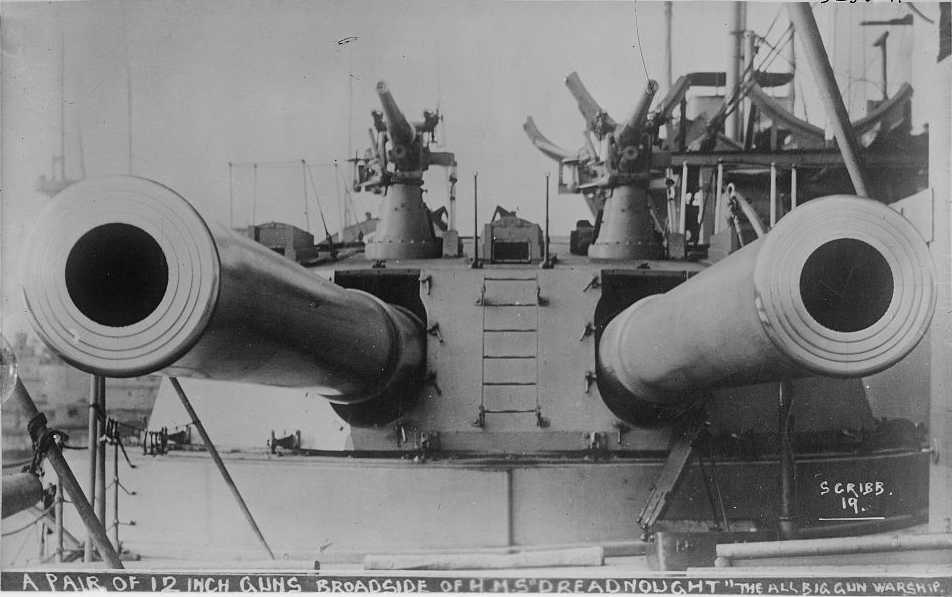
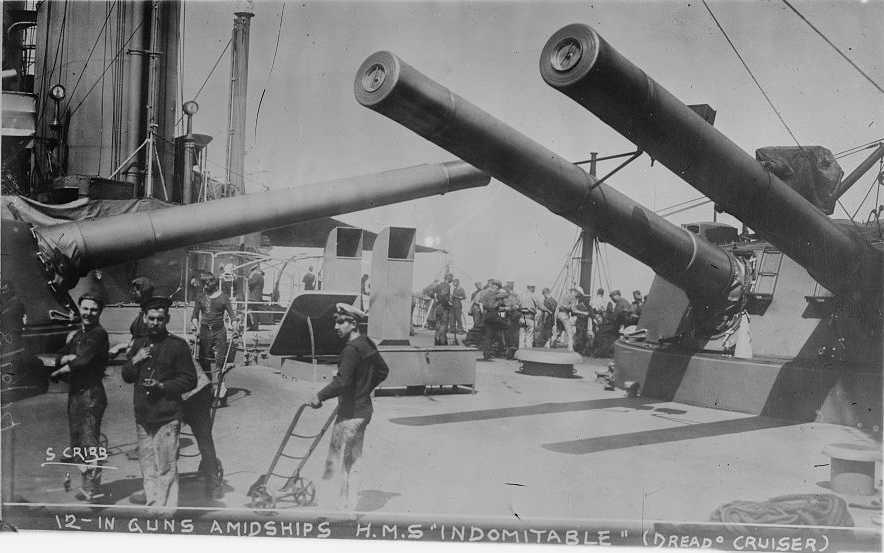
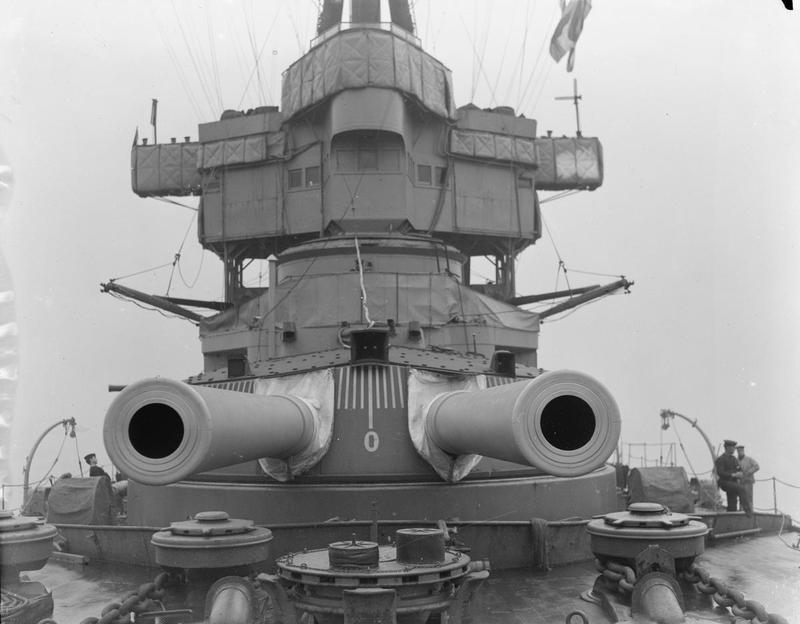
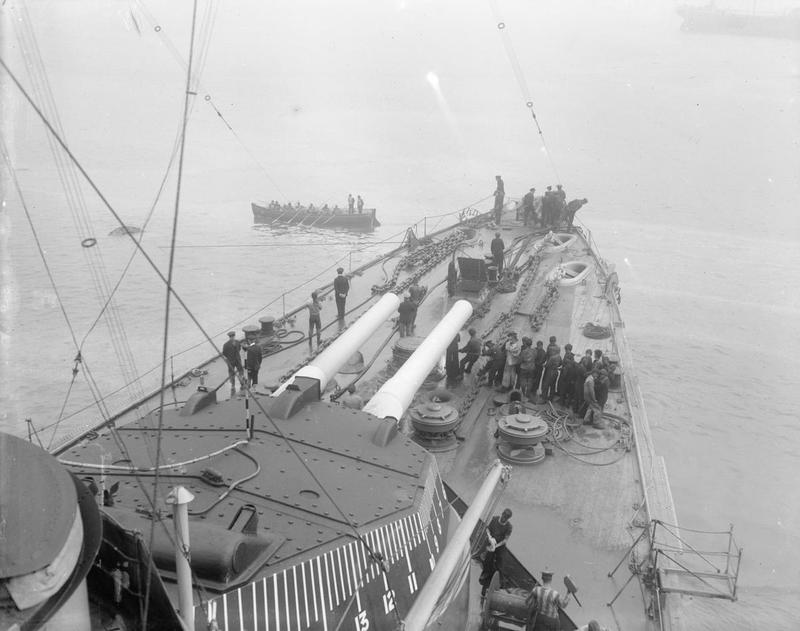
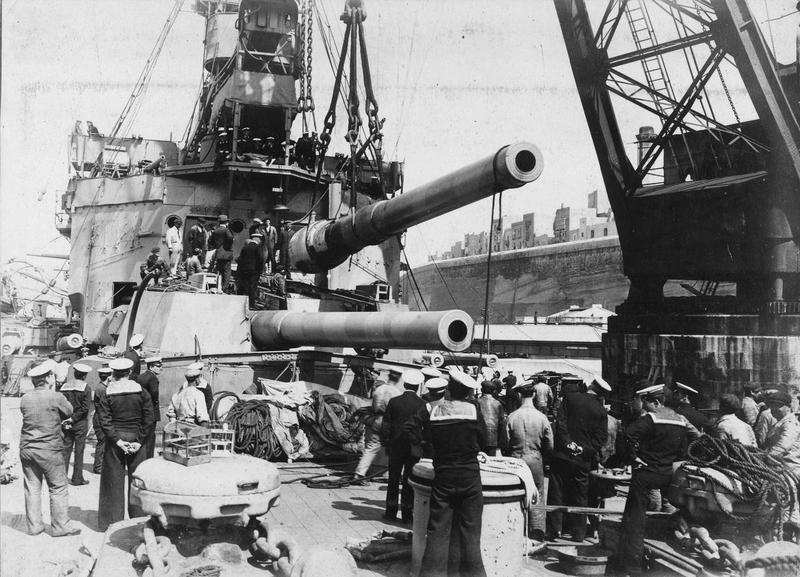
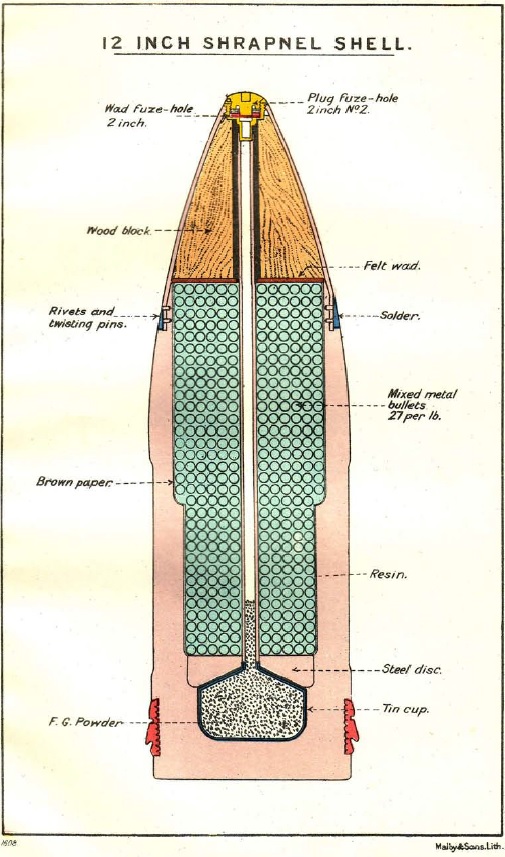
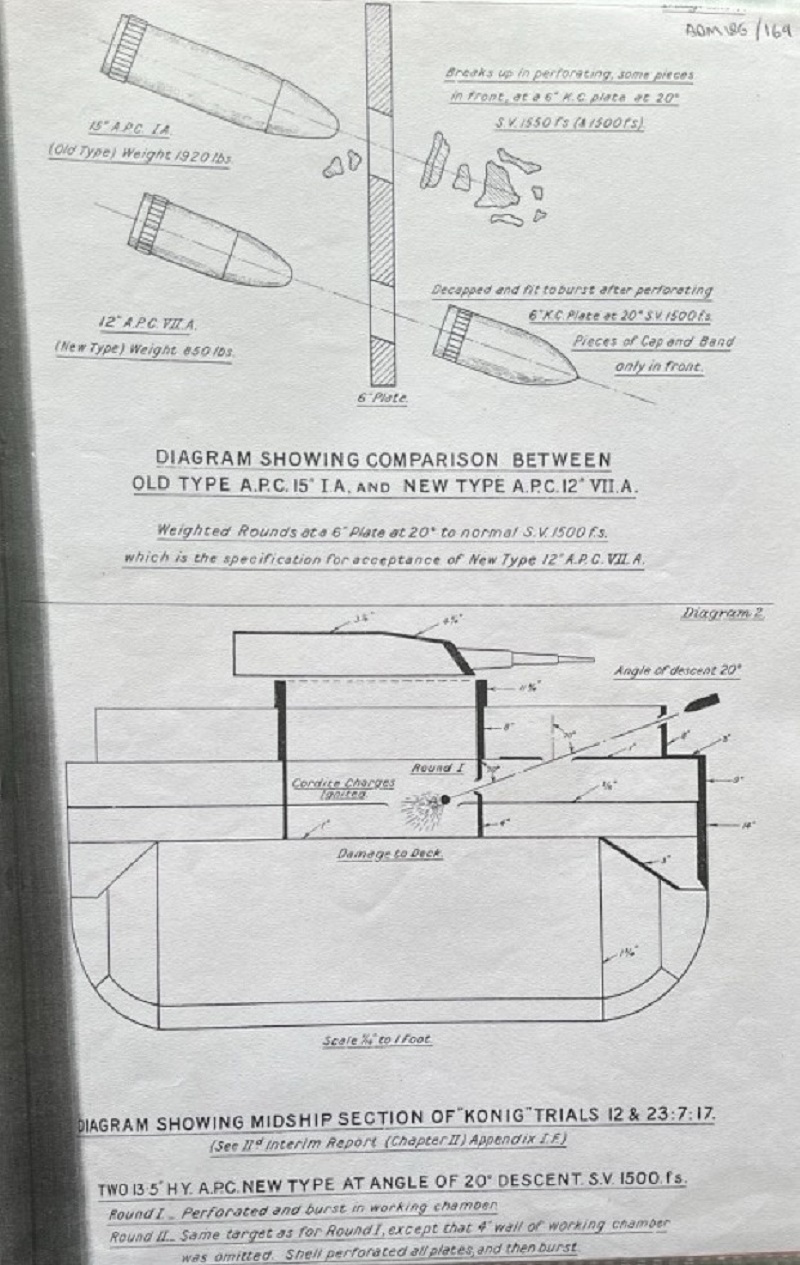
"Warrior to Dreadnought: Warship Development 1860-1905," "The Grand Fleet: Warship Design and Development 1906-1922" and "The Design and Construction of the Battleship Dreadnought" article in "Warship Volume IV" all by D.K. Brown
"British Battleships 1889-1904" and "British Battleships of World War One" both by R.A. Burt
"Warship Special 2: Battle Cruisers," "Jutland: An Analysis of the Fighting" and "British Naval Guns 1880-1945 No 4" article in "Warship Volume V" all by John Campbell
"Battleship Design and Development 1905-1945" and "Naval Weapons of World War I" both by Norman Friedman
"The Big Gun: Battleship Main Armament 1860-1945" by Peter Hodges
"British Battleships: 1860-1950" by Oscar Parkes
"Unyielding Air: Aerodynamic drag and Long Range Gunnery" article by P.G. Pugh in "Warship Volume X"
"British Battleships of World War Two" by Alan Raven and John Roberts
"Battlecruisers" by John Roberts
"A Concentrated Effort: Royal Navy Gunnery Exercises at the End of the Great War" article by William Schleihauf in "Warship International" No. 2, 1998
---
ADM 186/169 "Shell Committee: Reports 1917 and 1918"
"O.U. 5267: Ammunition Pocket Book 1924" by Admiralty, S.W. 1 (Gunnery Branch)
---
Special help from Neil Stirling
26 December 2008 - Benchmark
30 January 2009 - Added comment regarding breech mechanism
31 December 2011 - Added information about ammunition outfits in battlecruisers
11 March 2012 - Added notes about BVIII* mountings and loading transfers, fixed Australian War Memorial Link, added to picture captions
04 January 2014 - Replaced pictures of HMAS Australia
31 January 2014 - Added ammunition outfit for Bellerophon class
21 May 2014 - Added note about buzzers installed on Lord Nelson class
01 December 2015 - Updated links to Australian War Memorial and added photograph of HMS Agamemnon
23 September 2016 - Converted to HTML 5 format
21 December 2017 - Added information on Indefatigable mountings
13 March 2019 - Reorganized notes, added sketch of shrapnel projectile
29 February 2020 - Added notes in the ammunition section regarding 4crh APC
20 January 2021 - Added comments on gun development, liner life, DNO armor penetration table, and triple turret contract
12 November 2021 - Minor changes to formatting
11 February 2022 - Changed caption for photograph of HMS Agamemnon being regunned
02 April 2024 - Added Greenboy penetration sketch
14 November 2024 - Added armor thickness note
